Hyperthyroidism: Homeostasis, Drugs, and Optimal Treatment
VerifiedAdded on 2021/05/31
|10
|2459
|37
Homework Assignment
AI Summary
This assignment delves into the complexities of hyperthyroidism, beginning with an exploration of thyroid hormone homeostasis and its disruption in the context of Grave’s disease, including its symptoms and underlying mechanisms. The assignment examines the mode of action of various drugs, such as Carbimazole, Levothyroxine, Propranolol, and Cimetidine, used in the treatment of hyperthyroidism and related conditions. It further addresses potential pharmacological problems, including drug interactions and side effects, that may arise in patients undergoing treatment. The assignment also discusses the seven rights of medication administration, emphasizing patient safety and proper drug management. Finally, it proposes an optimal treatment plan for a patient with hyperthyroidism, including pharmacological and non-pharmacological interventions, to effectively manage the condition and improve patient outcomes. The plan includes the best antithyroid drugs, dosage and therapy duration, and adjustments like total thyroidectomy, beta-blockers, radiation therapy, and lifestyle modifications.

Running head: HYPERTHYROIDISM 1
Hyperthyroidism
Name
Institution
Hyperthyroidism
Name
Institution
Paraphrase This Document
Need a fresh take? Get an instant paraphrase of this document with our AI Paraphraser
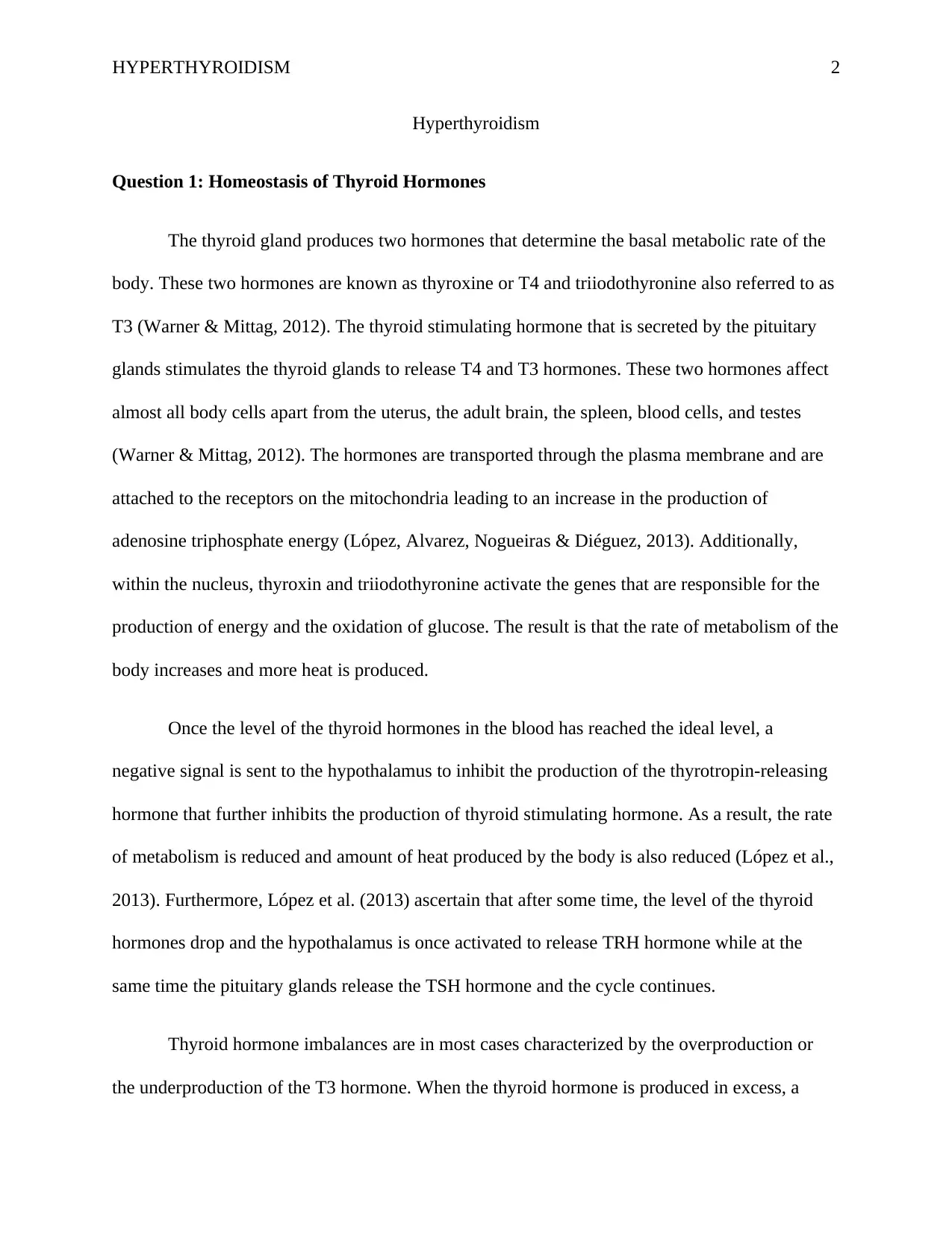
HYPERTHYROIDISM 2
Hyperthyroidism
Question 1: Homeostasis of Thyroid Hormones
The thyroid gland produces two hormones that determine the basal metabolic rate of the
body. These two hormones are known as thyroxine or T4 and triiodothyronine also referred to as
T3 (Warner & Mittag, 2012). The thyroid stimulating hormone that is secreted by the pituitary
glands stimulates the thyroid glands to release T4 and T3 hormones. These two hormones affect
almost all body cells apart from the uterus, the adult brain, the spleen, blood cells, and testes
(Warner & Mittag, 2012). The hormones are transported through the plasma membrane and are
attached to the receptors on the mitochondria leading to an increase in the production of
adenosine triphosphate energy (López, Alvarez, Nogueiras & Diéguez, 2013). Additionally,
within the nucleus, thyroxin and triiodothyronine activate the genes that are responsible for the
production of energy and the oxidation of glucose. The result is that the rate of metabolism of the
body increases and more heat is produced.
Once the level of the thyroid hormones in the blood has reached the ideal level, a
negative signal is sent to the hypothalamus to inhibit the production of the thyrotropin-releasing
hormone that further inhibits the production of thyroid stimulating hormone. As a result, the rate
of metabolism is reduced and amount of heat produced by the body is also reduced (López et al.,
2013). Furthermore, López et al. (2013) ascertain that after some time, the level of the thyroid
hormones drop and the hypothalamus is once activated to release TRH hormone while at the
same time the pituitary glands release the TSH hormone and the cycle continues.
Thyroid hormone imbalances are in most cases characterized by the overproduction or
the underproduction of the T3 hormone. When the thyroid hormone is produced in excess, a
Hyperthyroidism
Question 1: Homeostasis of Thyroid Hormones
The thyroid gland produces two hormones that determine the basal metabolic rate of the
body. These two hormones are known as thyroxine or T4 and triiodothyronine also referred to as
T3 (Warner & Mittag, 2012). The thyroid stimulating hormone that is secreted by the pituitary
glands stimulates the thyroid glands to release T4 and T3 hormones. These two hormones affect
almost all body cells apart from the uterus, the adult brain, the spleen, blood cells, and testes
(Warner & Mittag, 2012). The hormones are transported through the plasma membrane and are
attached to the receptors on the mitochondria leading to an increase in the production of
adenosine triphosphate energy (López, Alvarez, Nogueiras & Diéguez, 2013). Additionally,
within the nucleus, thyroxin and triiodothyronine activate the genes that are responsible for the
production of energy and the oxidation of glucose. The result is that the rate of metabolism of the
body increases and more heat is produced.
Once the level of the thyroid hormones in the blood has reached the ideal level, a
negative signal is sent to the hypothalamus to inhibit the production of the thyrotropin-releasing
hormone that further inhibits the production of thyroid stimulating hormone. As a result, the rate
of metabolism is reduced and amount of heat produced by the body is also reduced (López et al.,
2013). Furthermore, López et al. (2013) ascertain that after some time, the level of the thyroid
hormones drop and the hypothalamus is once activated to release TRH hormone while at the
same time the pituitary glands release the TSH hormone and the cycle continues.
Thyroid hormone imbalances are in most cases characterized by the overproduction or
the underproduction of the T3 hormone. When the thyroid hormone is produced in excess, a
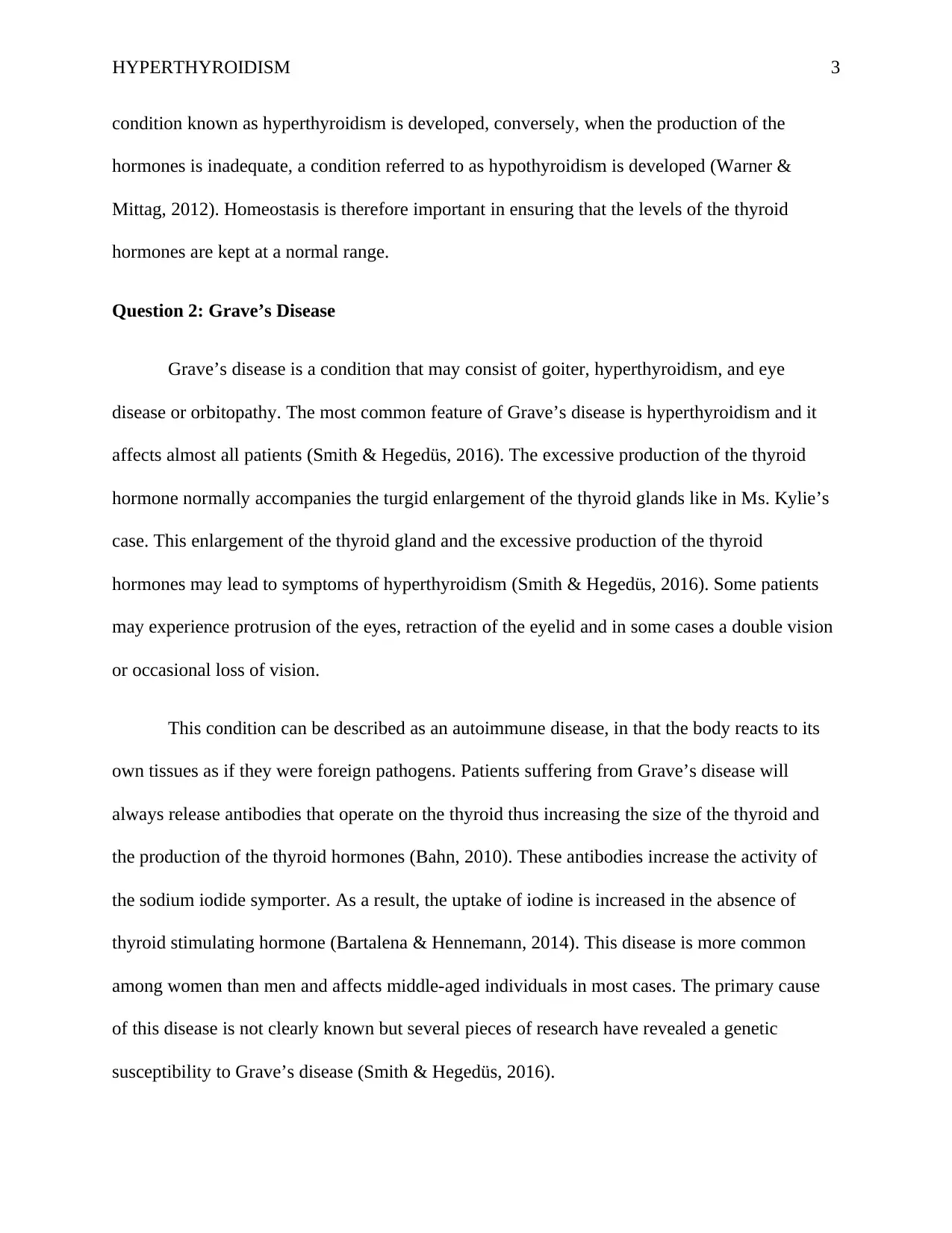
HYPERTHYROIDISM 3
condition known as hyperthyroidism is developed, conversely, when the production of the
hormones is inadequate, a condition referred to as hypothyroidism is developed (Warner &
Mittag, 2012). Homeostasis is therefore important in ensuring that the levels of the thyroid
hormones are kept at a normal range.
Question 2: Grave’s Disease
Grave’s disease is a condition that may consist of goiter, hyperthyroidism, and eye
disease or orbitopathy. The most common feature of Grave’s disease is hyperthyroidism and it
affects almost all patients (Smith & Hegedüs, 2016). The excessive production of the thyroid
hormone normally accompanies the turgid enlargement of the thyroid glands like in Ms. Kylie’s
case. This enlargement of the thyroid gland and the excessive production of the thyroid
hormones may lead to symptoms of hyperthyroidism (Smith & Hegedüs, 2016). Some patients
may experience protrusion of the eyes, retraction of the eyelid and in some cases a double vision
or occasional loss of vision.
This condition can be described as an autoimmune disease, in that the body reacts to its
own tissues as if they were foreign pathogens. Patients suffering from Grave’s disease will
always release antibodies that operate on the thyroid thus increasing the size of the thyroid and
the production of the thyroid hormones (Bahn, 2010). These antibodies increase the activity of
the sodium iodide symporter. As a result, the uptake of iodine is increased in the absence of
thyroid stimulating hormone (Bartalena & Hennemann, 2014). This disease is more common
among women than men and affects middle-aged individuals in most cases. The primary cause
of this disease is not clearly known but several pieces of research have revealed a genetic
susceptibility to Grave’s disease (Smith & Hegedüs, 2016).
condition known as hyperthyroidism is developed, conversely, when the production of the
hormones is inadequate, a condition referred to as hypothyroidism is developed (Warner &
Mittag, 2012). Homeostasis is therefore important in ensuring that the levels of the thyroid
hormones are kept at a normal range.
Question 2: Grave’s Disease
Grave’s disease is a condition that may consist of goiter, hyperthyroidism, and eye
disease or orbitopathy. The most common feature of Grave’s disease is hyperthyroidism and it
affects almost all patients (Smith & Hegedüs, 2016). The excessive production of the thyroid
hormone normally accompanies the turgid enlargement of the thyroid glands like in Ms. Kylie’s
case. This enlargement of the thyroid gland and the excessive production of the thyroid
hormones may lead to symptoms of hyperthyroidism (Smith & Hegedüs, 2016). Some patients
may experience protrusion of the eyes, retraction of the eyelid and in some cases a double vision
or occasional loss of vision.
This condition can be described as an autoimmune disease, in that the body reacts to its
own tissues as if they were foreign pathogens. Patients suffering from Grave’s disease will
always release antibodies that operate on the thyroid thus increasing the size of the thyroid and
the production of the thyroid hormones (Bahn, 2010). These antibodies increase the activity of
the sodium iodide symporter. As a result, the uptake of iodine is increased in the absence of
thyroid stimulating hormone (Bartalena & Hennemann, 2014). This disease is more common
among women than men and affects middle-aged individuals in most cases. The primary cause
of this disease is not clearly known but several pieces of research have revealed a genetic
susceptibility to Grave’s disease (Smith & Hegedüs, 2016).
⊘ This is a preview!⊘
Do you want full access?
Subscribe today to unlock all pages.

Trusted by 1+ million students worldwide
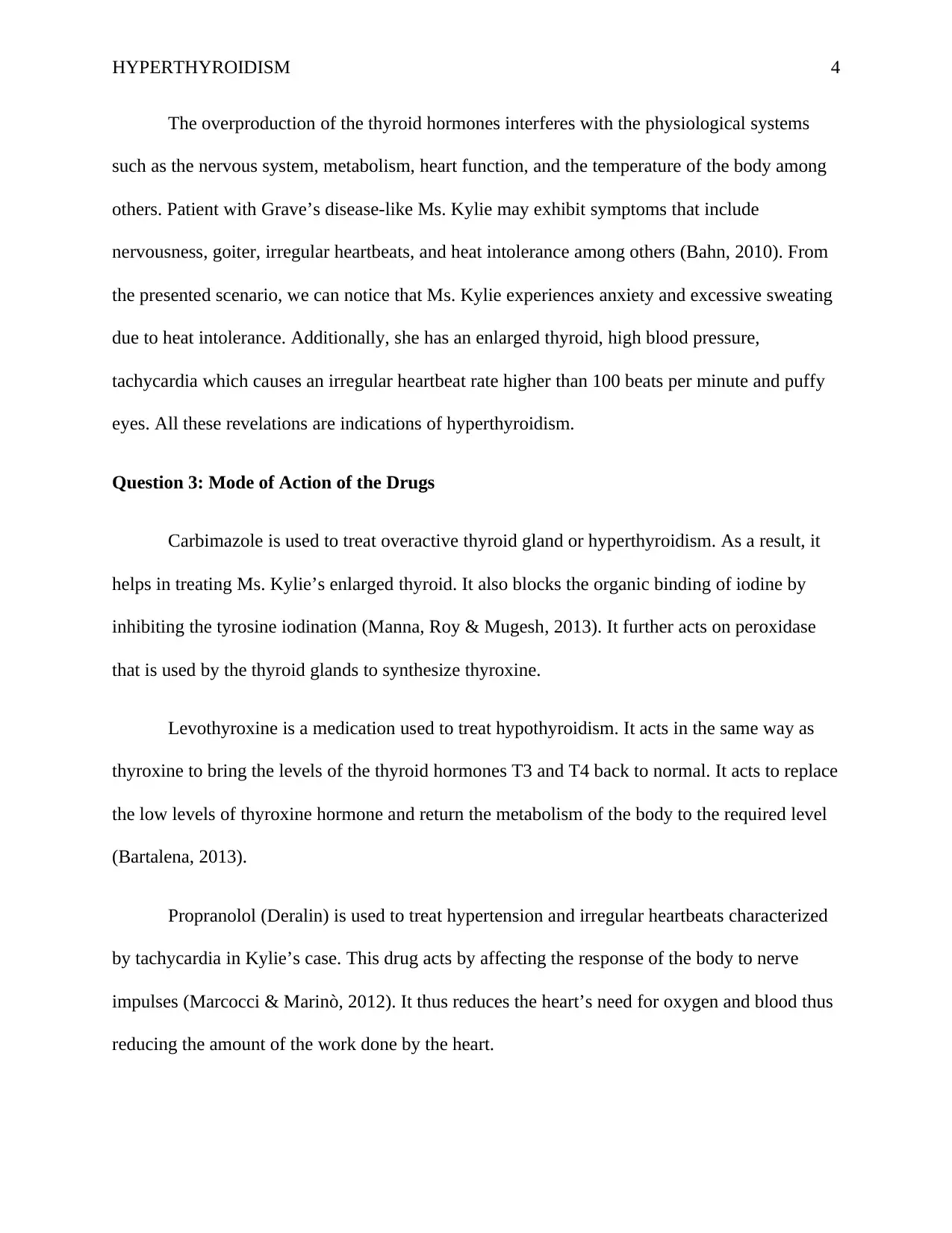
HYPERTHYROIDISM 4
The overproduction of the thyroid hormones interferes with the physiological systems
such as the nervous system, metabolism, heart function, and the temperature of the body among
others. Patient with Grave’s disease-like Ms. Kylie may exhibit symptoms that include
nervousness, goiter, irregular heartbeats, and heat intolerance among others (Bahn, 2010). From
the presented scenario, we can notice that Ms. Kylie experiences anxiety and excessive sweating
due to heat intolerance. Additionally, she has an enlarged thyroid, high blood pressure,
tachycardia which causes an irregular heartbeat rate higher than 100 beats per minute and puffy
eyes. All these revelations are indications of hyperthyroidism.
Question 3: Mode of Action of the Drugs
Carbimazole is used to treat overactive thyroid gland or hyperthyroidism. As a result, it
helps in treating Ms. Kylie’s enlarged thyroid. It also blocks the organic binding of iodine by
inhibiting the tyrosine iodination (Manna, Roy & Mugesh, 2013). It further acts on peroxidase
that is used by the thyroid glands to synthesize thyroxine.
Levothyroxine is a medication used to treat hypothyroidism. It acts in the same way as
thyroxine to bring the levels of the thyroid hormones T3 and T4 back to normal. It acts to replace
the low levels of thyroxine hormone and return the metabolism of the body to the required level
(Bartalena, 2013).
Propranolol (Deralin) is used to treat hypertension and irregular heartbeats characterized
by tachycardia in Kylie’s case. This drug acts by affecting the response of the body to nerve
impulses (Marcocci & Marinò, 2012). It thus reduces the heart’s need for oxygen and blood thus
reducing the amount of the work done by the heart.
The overproduction of the thyroid hormones interferes with the physiological systems
such as the nervous system, metabolism, heart function, and the temperature of the body among
others. Patient with Grave’s disease-like Ms. Kylie may exhibit symptoms that include
nervousness, goiter, irregular heartbeats, and heat intolerance among others (Bahn, 2010). From
the presented scenario, we can notice that Ms. Kylie experiences anxiety and excessive sweating
due to heat intolerance. Additionally, she has an enlarged thyroid, high blood pressure,
tachycardia which causes an irregular heartbeat rate higher than 100 beats per minute and puffy
eyes. All these revelations are indications of hyperthyroidism.
Question 3: Mode of Action of the Drugs
Carbimazole is used to treat overactive thyroid gland or hyperthyroidism. As a result, it
helps in treating Ms. Kylie’s enlarged thyroid. It also blocks the organic binding of iodine by
inhibiting the tyrosine iodination (Manna, Roy & Mugesh, 2013). It further acts on peroxidase
that is used by the thyroid glands to synthesize thyroxine.
Levothyroxine is a medication used to treat hypothyroidism. It acts in the same way as
thyroxine to bring the levels of the thyroid hormones T3 and T4 back to normal. It acts to replace
the low levels of thyroxine hormone and return the metabolism of the body to the required level
(Bartalena, 2013).
Propranolol (Deralin) is used to treat hypertension and irregular heartbeats characterized
by tachycardia in Kylie’s case. This drug acts by affecting the response of the body to nerve
impulses (Marcocci & Marinò, 2012). It thus reduces the heart’s need for oxygen and blood thus
reducing the amount of the work done by the heart.
Paraphrase This Document
Need a fresh take? Get an instant paraphrase of this document with our AI Paraphraser
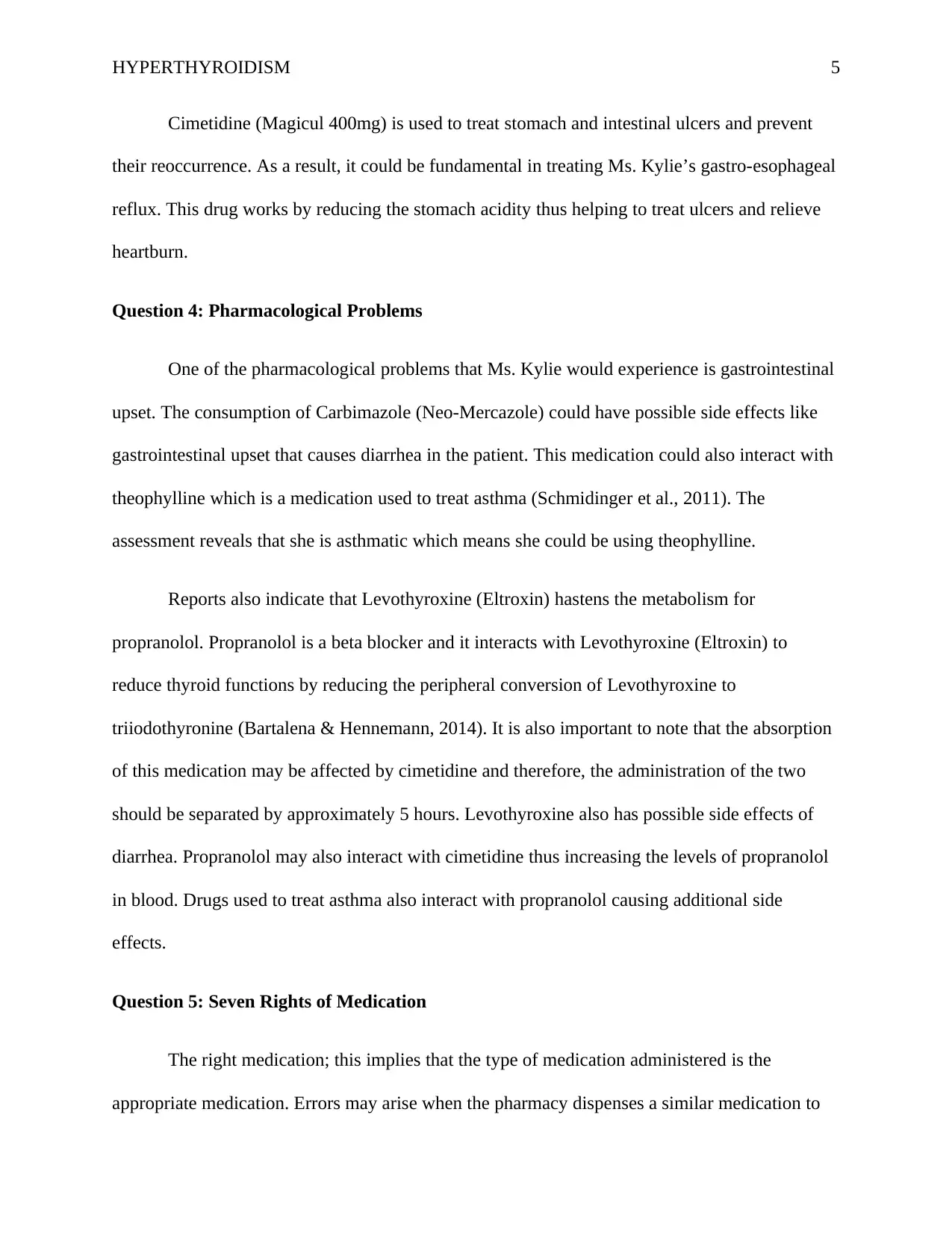
HYPERTHYROIDISM 5
Cimetidine (Magicul 400mg) is used to treat stomach and intestinal ulcers and prevent
their reoccurrence. As a result, it could be fundamental in treating Ms. Kylie’s gastro-esophageal
reflux. This drug works by reducing the stomach acidity thus helping to treat ulcers and relieve
heartburn.
Question 4: Pharmacological Problems
One of the pharmacological problems that Ms. Kylie would experience is gastrointestinal
upset. The consumption of Carbimazole (Neo-Mercazole) could have possible side effects like
gastrointestinal upset that causes diarrhea in the patient. This medication could also interact with
theophylline which is a medication used to treat asthma (Schmidinger et al., 2011). The
assessment reveals that she is asthmatic which means she could be using theophylline.
Reports also indicate that Levothyroxine (Eltroxin) hastens the metabolism for
propranolol. Propranolol is a beta blocker and it interacts with Levothyroxine (Eltroxin) to
reduce thyroid functions by reducing the peripheral conversion of Levothyroxine to
triiodothyronine (Bartalena & Hennemann, 2014). It is also important to note that the absorption
of this medication may be affected by cimetidine and therefore, the administration of the two
should be separated by approximately 5 hours. Levothyroxine also has possible side effects of
diarrhea. Propranolol may also interact with cimetidine thus increasing the levels of propranolol
in blood. Drugs used to treat asthma also interact with propranolol causing additional side
effects.
Question 5: Seven Rights of Medication
The right medication; this implies that the type of medication administered is the
appropriate medication. Errors may arise when the pharmacy dispenses a similar medication to
Cimetidine (Magicul 400mg) is used to treat stomach and intestinal ulcers and prevent
their reoccurrence. As a result, it could be fundamental in treating Ms. Kylie’s gastro-esophageal
reflux. This drug works by reducing the stomach acidity thus helping to treat ulcers and relieve
heartburn.
Question 4: Pharmacological Problems
One of the pharmacological problems that Ms. Kylie would experience is gastrointestinal
upset. The consumption of Carbimazole (Neo-Mercazole) could have possible side effects like
gastrointestinal upset that causes diarrhea in the patient. This medication could also interact with
theophylline which is a medication used to treat asthma (Schmidinger et al., 2011). The
assessment reveals that she is asthmatic which means she could be using theophylline.
Reports also indicate that Levothyroxine (Eltroxin) hastens the metabolism for
propranolol. Propranolol is a beta blocker and it interacts with Levothyroxine (Eltroxin) to
reduce thyroid functions by reducing the peripheral conversion of Levothyroxine to
triiodothyronine (Bartalena & Hennemann, 2014). It is also important to note that the absorption
of this medication may be affected by cimetidine and therefore, the administration of the two
should be separated by approximately 5 hours. Levothyroxine also has possible side effects of
diarrhea. Propranolol may also interact with cimetidine thus increasing the levels of propranolol
in blood. Drugs used to treat asthma also interact with propranolol causing additional side
effects.
Question 5: Seven Rights of Medication
The right medication; this implies that the type of medication administered is the
appropriate medication. Errors may arise when the pharmacy dispenses a similar medication to
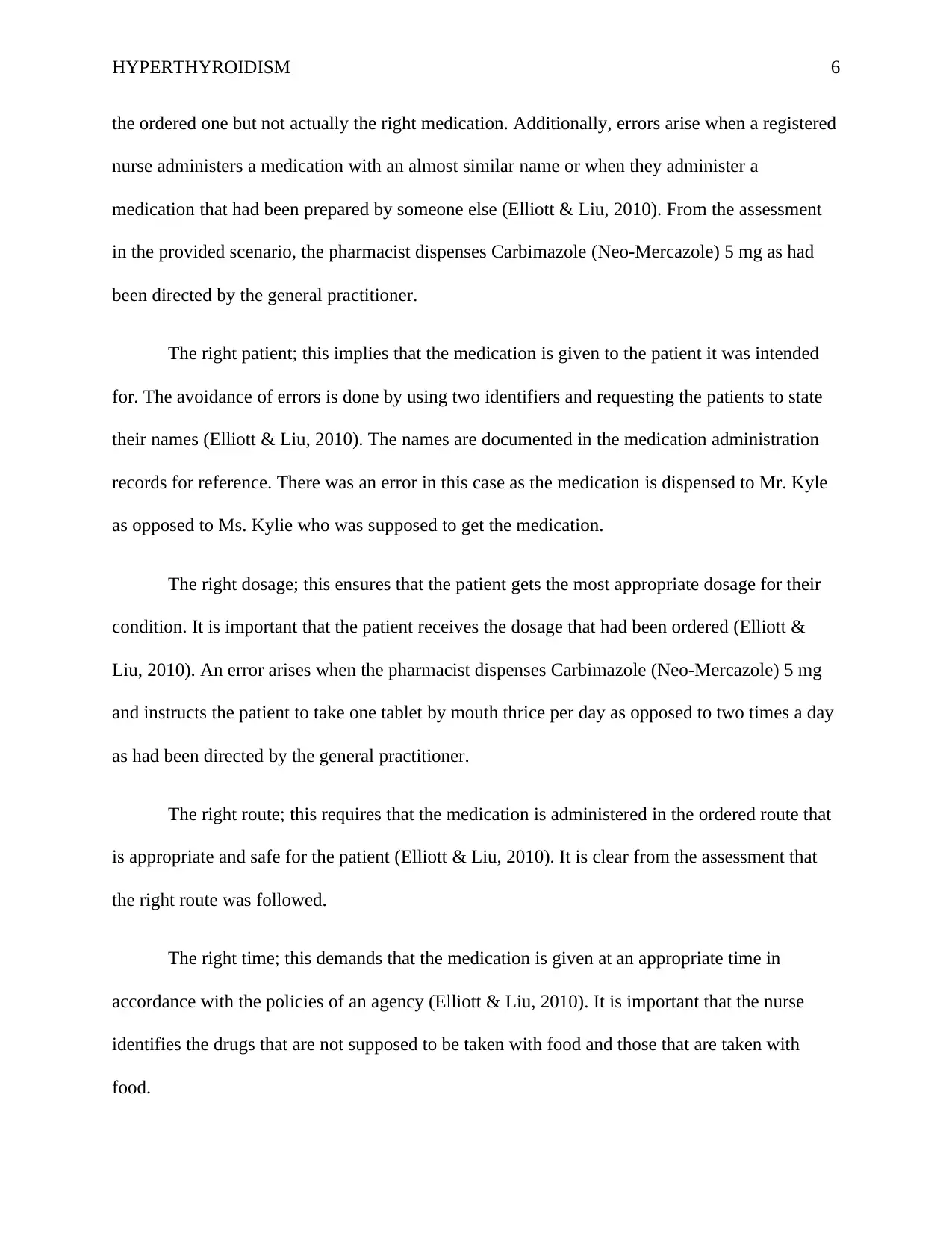
HYPERTHYROIDISM 6
the ordered one but not actually the right medication. Additionally, errors arise when a registered
nurse administers a medication with an almost similar name or when they administer a
medication that had been prepared by someone else (Elliott & Liu, 2010). From the assessment
in the provided scenario, the pharmacist dispenses Carbimazole (Neo-Mercazole) 5 mg as had
been directed by the general practitioner.
The right patient; this implies that the medication is given to the patient it was intended
for. The avoidance of errors is done by using two identifiers and requesting the patients to state
their names (Elliott & Liu, 2010). The names are documented in the medication administration
records for reference. There was an error in this case as the medication is dispensed to Mr. Kyle
as opposed to Ms. Kylie who was supposed to get the medication.
The right dosage; this ensures that the patient gets the most appropriate dosage for their
condition. It is important that the patient receives the dosage that had been ordered (Elliott &
Liu, 2010). An error arises when the pharmacist dispenses Carbimazole (Neo-Mercazole) 5 mg
and instructs the patient to take one tablet by mouth thrice per day as opposed to two times a day
as had been directed by the general practitioner.
The right route; this requires that the medication is administered in the ordered route that
is appropriate and safe for the patient (Elliott & Liu, 2010). It is clear from the assessment that
the right route was followed.
The right time; this demands that the medication is given at an appropriate time in
accordance with the policies of an agency (Elliott & Liu, 2010). It is important that the nurse
identifies the drugs that are not supposed to be taken with food and those that are taken with
food.
the ordered one but not actually the right medication. Additionally, errors arise when a registered
nurse administers a medication with an almost similar name or when they administer a
medication that had been prepared by someone else (Elliott & Liu, 2010). From the assessment
in the provided scenario, the pharmacist dispenses Carbimazole (Neo-Mercazole) 5 mg as had
been directed by the general practitioner.
The right patient; this implies that the medication is given to the patient it was intended
for. The avoidance of errors is done by using two identifiers and requesting the patients to state
their names (Elliott & Liu, 2010). The names are documented in the medication administration
records for reference. There was an error in this case as the medication is dispensed to Mr. Kyle
as opposed to Ms. Kylie who was supposed to get the medication.
The right dosage; this ensures that the patient gets the most appropriate dosage for their
condition. It is important that the patient receives the dosage that had been ordered (Elliott &
Liu, 2010). An error arises when the pharmacist dispenses Carbimazole (Neo-Mercazole) 5 mg
and instructs the patient to take one tablet by mouth thrice per day as opposed to two times a day
as had been directed by the general practitioner.
The right route; this requires that the medication is administered in the ordered route that
is appropriate and safe for the patient (Elliott & Liu, 2010). It is clear from the assessment that
the right route was followed.
The right time; this demands that the medication is given at an appropriate time in
accordance with the policies of an agency (Elliott & Liu, 2010). It is important that the nurse
identifies the drugs that are not supposed to be taken with food and those that are taken with
food.
⊘ This is a preview!⊘
Do you want full access?
Subscribe today to unlock all pages.

Trusted by 1+ million students worldwide
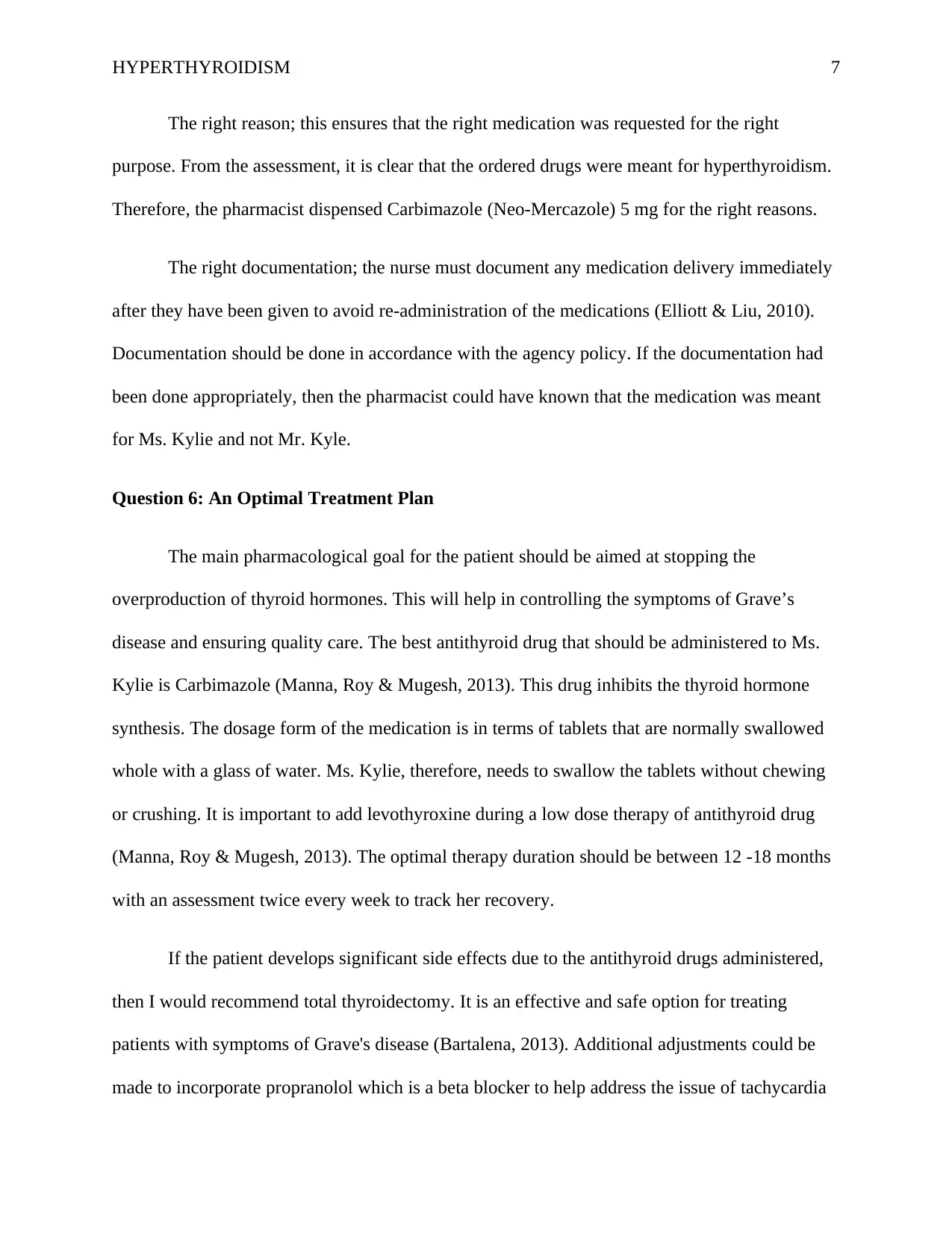
HYPERTHYROIDISM 7
The right reason; this ensures that the right medication was requested for the right
purpose. From the assessment, it is clear that the ordered drugs were meant for hyperthyroidism.
Therefore, the pharmacist dispensed Carbimazole (Neo-Mercazole) 5 mg for the right reasons.
The right documentation; the nurse must document any medication delivery immediately
after they have been given to avoid re-administration of the medications (Elliott & Liu, 2010).
Documentation should be done in accordance with the agency policy. If the documentation had
been done appropriately, then the pharmacist could have known that the medication was meant
for Ms. Kylie and not Mr. Kyle.
Question 6: An Optimal Treatment Plan
The main pharmacological goal for the patient should be aimed at stopping the
overproduction of thyroid hormones. This will help in controlling the symptoms of Grave’s
disease and ensuring quality care. The best antithyroid drug that should be administered to Ms.
Kylie is Carbimazole (Manna, Roy & Mugesh, 2013). This drug inhibits the thyroid hormone
synthesis. The dosage form of the medication is in terms of tablets that are normally swallowed
whole with a glass of water. Ms. Kylie, therefore, needs to swallow the tablets without chewing
or crushing. It is important to add levothyroxine during a low dose therapy of antithyroid drug
(Manna, Roy & Mugesh, 2013). The optimal therapy duration should be between 12 -18 months
with an assessment twice every week to track her recovery.
If the patient develops significant side effects due to the antithyroid drugs administered,
then I would recommend total thyroidectomy. It is an effective and safe option for treating
patients with symptoms of Grave's disease (Bartalena, 2013). Additional adjustments could be
made to incorporate propranolol which is a beta blocker to help address the issue of tachycardia
The right reason; this ensures that the right medication was requested for the right
purpose. From the assessment, it is clear that the ordered drugs were meant for hyperthyroidism.
Therefore, the pharmacist dispensed Carbimazole (Neo-Mercazole) 5 mg for the right reasons.
The right documentation; the nurse must document any medication delivery immediately
after they have been given to avoid re-administration of the medications (Elliott & Liu, 2010).
Documentation should be done in accordance with the agency policy. If the documentation had
been done appropriately, then the pharmacist could have known that the medication was meant
for Ms. Kylie and not Mr. Kyle.
Question 6: An Optimal Treatment Plan
The main pharmacological goal for the patient should be aimed at stopping the
overproduction of thyroid hormones. This will help in controlling the symptoms of Grave’s
disease and ensuring quality care. The best antithyroid drug that should be administered to Ms.
Kylie is Carbimazole (Manna, Roy & Mugesh, 2013). This drug inhibits the thyroid hormone
synthesis. The dosage form of the medication is in terms of tablets that are normally swallowed
whole with a glass of water. Ms. Kylie, therefore, needs to swallow the tablets without chewing
or crushing. It is important to add levothyroxine during a low dose therapy of antithyroid drug
(Manna, Roy & Mugesh, 2013). The optimal therapy duration should be between 12 -18 months
with an assessment twice every week to track her recovery.
If the patient develops significant side effects due to the antithyroid drugs administered,
then I would recommend total thyroidectomy. It is an effective and safe option for treating
patients with symptoms of Grave's disease (Bartalena, 2013). Additional adjustments could be
made to incorporate propranolol which is a beta blocker to help address the issue of tachycardia
Paraphrase This Document
Need a fresh take? Get an instant paraphrase of this document with our AI Paraphraser

HYPERTHYROIDISM 8
and anxiety. Radiation therapy is also an important adjustment to treating this condition
(Matthiesen et al., 2012). Some non-pharmacological therapies that could be used to treat Ms.
Kylie include good eating habits, routine exercises, and stress avoidance (Passani & Blandina,
2011).
and anxiety. Radiation therapy is also an important adjustment to treating this condition
(Matthiesen et al., 2012). Some non-pharmacological therapies that could be used to treat Ms.
Kylie include good eating habits, routine exercises, and stress avoidance (Passani & Blandina,
2011).
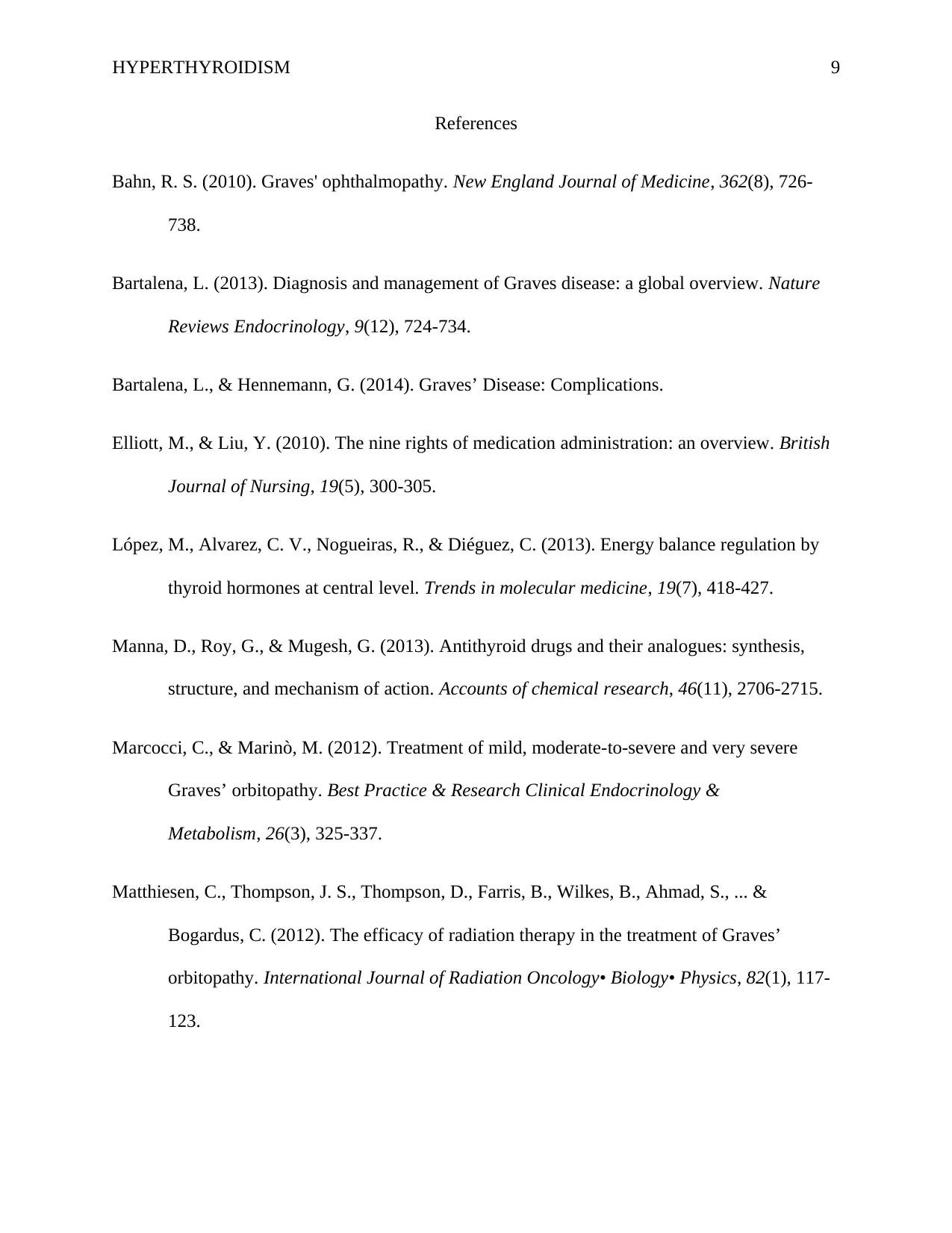
HYPERTHYROIDISM 9
References
Bahn, R. S. (2010). Graves' ophthalmopathy. New England Journal of Medicine, 362(8), 726-
738.
Bartalena, L. (2013). Diagnosis and management of Graves disease: a global overview. Nature
Reviews Endocrinology, 9(12), 724-734.
Bartalena, L., & Hennemann, G. (2014). Graves’ Disease: Complications.
Elliott, M., & Liu, Y. (2010). The nine rights of medication administration: an overview. British
Journal of Nursing, 19(5), 300-305.
López, M., Alvarez, C. V., Nogueiras, R., & Diéguez, C. (2013). Energy balance regulation by
thyroid hormones at central level. Trends in molecular medicine, 19(7), 418-427.
Manna, D., Roy, G., & Mugesh, G. (2013). Antithyroid drugs and their analogues: synthesis,
structure, and mechanism of action. Accounts of chemical research, 46(11), 2706-2715.
Marcocci, C., & Marinò, M. (2012). Treatment of mild, moderate-to-severe and very severe
Graves’ orbitopathy. Best Practice & Research Clinical Endocrinology &
Metabolism, 26(3), 325-337.
Matthiesen, C., Thompson, J. S., Thompson, D., Farris, B., Wilkes, B., Ahmad, S., ... &
Bogardus, C. (2012). The efficacy of radiation therapy in the treatment of Graves’
orbitopathy. International Journal of Radiation Oncology• Biology• Physics, 82(1), 117-
123.
References
Bahn, R. S. (2010). Graves' ophthalmopathy. New England Journal of Medicine, 362(8), 726-
738.
Bartalena, L. (2013). Diagnosis and management of Graves disease: a global overview. Nature
Reviews Endocrinology, 9(12), 724-734.
Bartalena, L., & Hennemann, G. (2014). Graves’ Disease: Complications.
Elliott, M., & Liu, Y. (2010). The nine rights of medication administration: an overview. British
Journal of Nursing, 19(5), 300-305.
López, M., Alvarez, C. V., Nogueiras, R., & Diéguez, C. (2013). Energy balance regulation by
thyroid hormones at central level. Trends in molecular medicine, 19(7), 418-427.
Manna, D., Roy, G., & Mugesh, G. (2013). Antithyroid drugs and their analogues: synthesis,
structure, and mechanism of action. Accounts of chemical research, 46(11), 2706-2715.
Marcocci, C., & Marinò, M. (2012). Treatment of mild, moderate-to-severe and very severe
Graves’ orbitopathy. Best Practice & Research Clinical Endocrinology &
Metabolism, 26(3), 325-337.
Matthiesen, C., Thompson, J. S., Thompson, D., Farris, B., Wilkes, B., Ahmad, S., ... &
Bogardus, C. (2012). The efficacy of radiation therapy in the treatment of Graves’
orbitopathy. International Journal of Radiation Oncology• Biology• Physics, 82(1), 117-
123.
⊘ This is a preview!⊘
Do you want full access?
Subscribe today to unlock all pages.

Trusted by 1+ million students worldwide
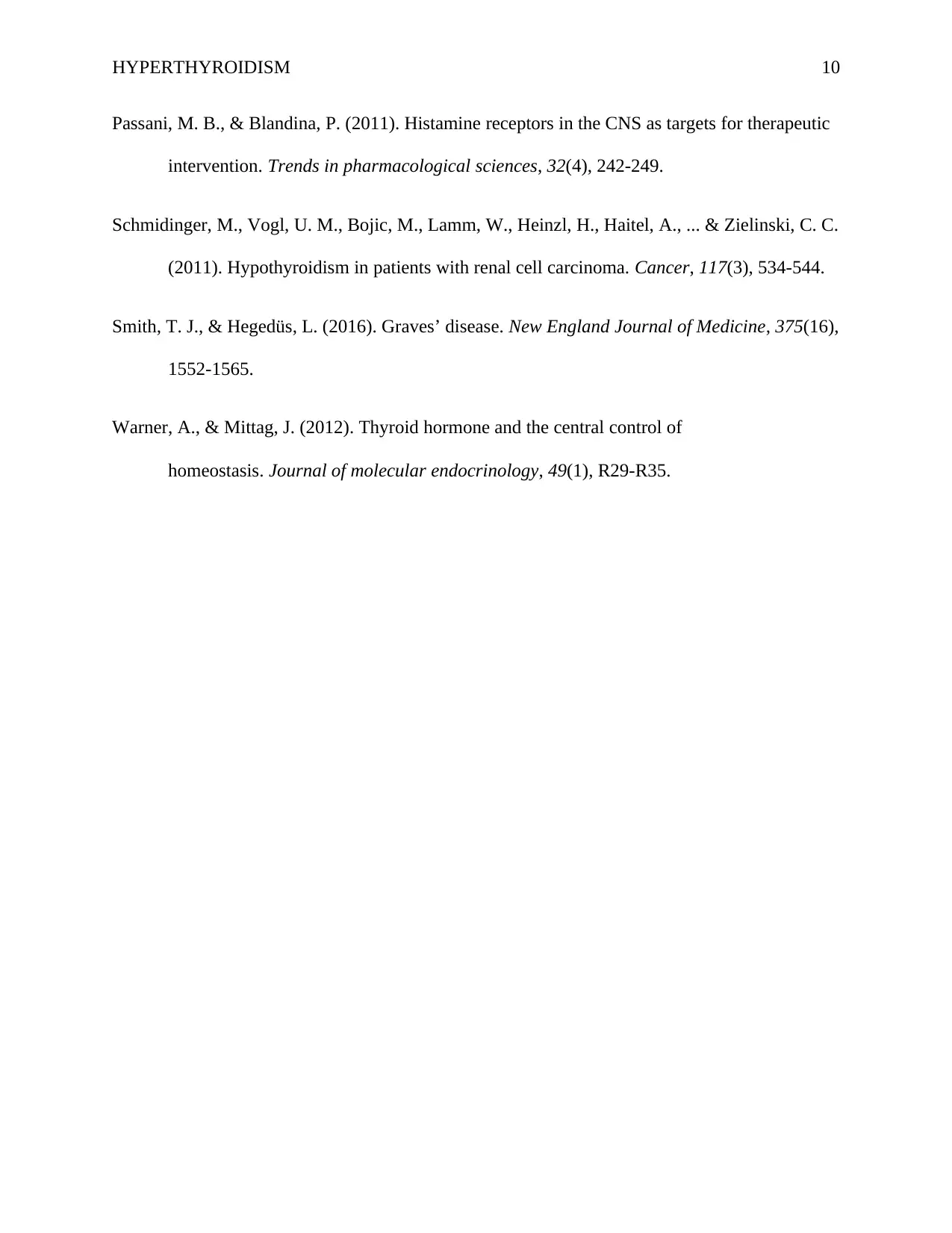
HYPERTHYROIDISM 10
Passani, M. B., & Blandina, P. (2011). Histamine receptors in the CNS as targets for therapeutic
intervention. Trends in pharmacological sciences, 32(4), 242-249.
Schmidinger, M., Vogl, U. M., Bojic, M., Lamm, W., Heinzl, H., Haitel, A., ... & Zielinski, C. C.
(2011). Hypothyroidism in patients with renal cell carcinoma. Cancer, 117(3), 534-544.
Smith, T. J., & Hegedüs, L. (2016). Graves’ disease. New England Journal of Medicine, 375(16),
1552-1565.
Warner, A., & Mittag, J. (2012). Thyroid hormone and the central control of
homeostasis. Journal of molecular endocrinology, 49(1), R29-R35.
Passani, M. B., & Blandina, P. (2011). Histamine receptors in the CNS as targets for therapeutic
intervention. Trends in pharmacological sciences, 32(4), 242-249.
Schmidinger, M., Vogl, U. M., Bojic, M., Lamm, W., Heinzl, H., Haitel, A., ... & Zielinski, C. C.
(2011). Hypothyroidism in patients with renal cell carcinoma. Cancer, 117(3), 534-544.
Smith, T. J., & Hegedüs, L. (2016). Graves’ disease. New England Journal of Medicine, 375(16),
1552-1565.
Warner, A., & Mittag, J. (2012). Thyroid hormone and the central control of
homeostasis. Journal of molecular endocrinology, 49(1), R29-R35.
1 out of 10
Related Documents
Your All-in-One AI-Powered Toolkit for Academic Success.
+13062052269
info@desklib.com
Available 24*7 on WhatsApp / Email
![[object Object]](/_next/static/media/star-bottom.7253800d.svg)
Unlock your academic potential
Copyright © 2020–2025 A2Z Services. All Rights Reserved. Developed and managed by ZUCOL.





